We started out today in pouring rain. At least parking was free on Sundays in Frederick, MD! Our previous two Frederick, MD posts were on 2/7/2022.
 |
| Carroll Creek |
 |
| Classics (2000, by George Lundeen) depicts a teenaged boy reading to younger children: the words inscribed are from The Star Spangled Banner |
 |
| The National Museum of Civil War Medicine is housed in a building that had undertakers on the second floor, who had built caskets and embalmed soldiers during the Civil War |
 |
| Several murals in the corridors put us on the scene |
 |
| An original tent used by Surgeon John Wiley, who was at the Battle of Gettysburg |
 |
| The portable desk of Major Jonathan Letterman, who, as medical director of the Army of the Potomac, created the Ambulance Corps, revolutionizing the treatment of wounded soldiers |
 |
| The first Ambulance Corps |
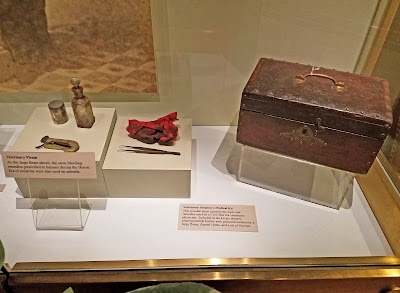 | |
|
 |
| A prosthetic arm developed by Marvin Lincoln, patented in 1863, had a locking elbow joint and a thumb with a spring to hold small objects |
 |
| A hospital supply backpack carried by medical personnel at field dressing stations closer to battle sites |
 |
| A couple of stewards administer first aid in the field |
 |
| More severe wounds were tended at the field hospitals |
 |
| The Antietam Arm, is naturally preserved and was reported to have been found at the battlefield of Antietam (a Roadside America attraction) |
 |
| A complete Surgeon's Capital Operating Kit that contains tools sufficient for most procedures |
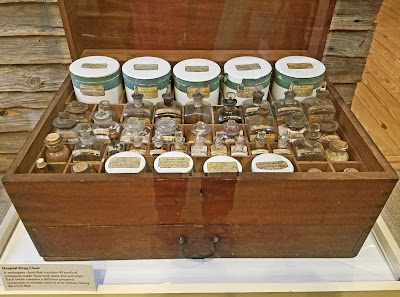 |
| A hospital drug chest with 48 different prepared compounds or mixtures |
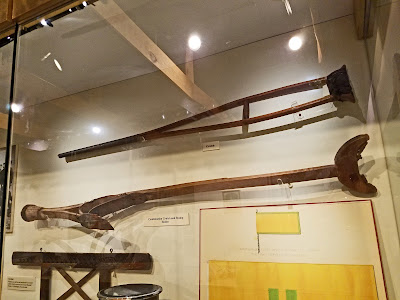 |
| A crutch, and another crutch with a leg stump holder |
 |
| A model of an early hospital; after the Civil War, hospitals became known or accepted as places of healing |
 |
| Nuns, or Sisters, were already trained in the healing arts and became the first nurses in hospitals |
 |
| Embalming of the dead soldiers was also often performed in field hospitals, especially since transportation companies refused to deliver bodies that were not embalmed |
 |
| The former Tivoli Theatre (1926, by John Jacob Zink blending Classical Revival and Beaux Arts styles) |
 |
| The Dreaming (2007, by William Cochran) is an art installation of glass and paint |
 |
| Pythian Castle (1912, by Benjamin Evard Kepner in Gothic Revival and Beaux Arts styles) |
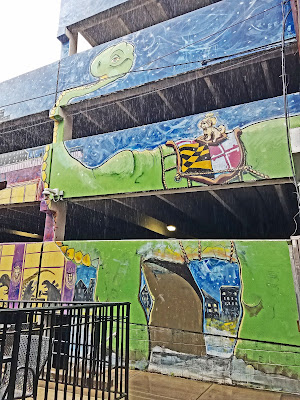 |
| Dinosaur Mural (2017, by Goodloe Byron) depicts an Astrodon johnstoni, Maryland's State dinosaur |
 |
| Former Town Hall and Marketplace (1765-1769) now houses Brewer's Alley, where we had lunch |
 |
| Hardey Building (1936, in Art Deco style) |
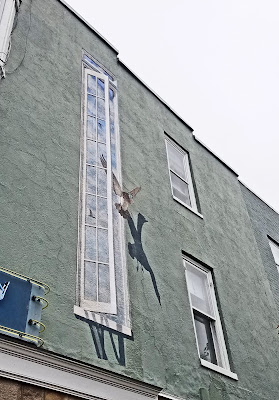 |
| One of William Cochran's trompe l'oeil murals, Egress (1988) shows a wood duck entering the street from a sky inside the building |
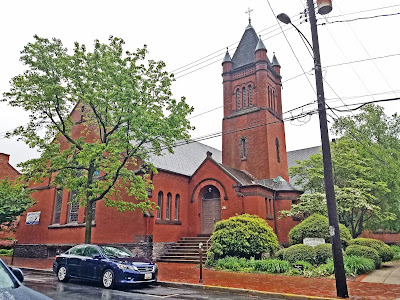 |
| Evangelical Lutheran Sunday School (1890, by the Dempwolf architecture firm in Richardsonian Romanesque style) |
 |
| Houck Mansion (1900, by Dempwolf, in Richardsonian Romanesque style) |
 |
| Rowhouses along E Third Street |
 |
| Fancier rowhouses on E Third Street |
 |
| Former Visitation Academy (1846), the only school to remain open during the Civil War as it was the site of a Civil War encampment |
 |
| St John the Evangelist Roman Catholic Church (1836); while other churches served as Civil War hospitals, this one was used to jail Confederate soldiers because of its high windows |
 |
| Shab Row once housed tinkers, wheelwrights and others who serviced stagecoaches traveling the National Road in the 1800s |
 |
| Trail House (1852, by Colonel Charles Trail in Italianate style) |
 |
| The Museum of Frederick County History occupies this house (1824) that was used as an orphanage until 1959 |
 |
| Evangelical Lutheran Church (1854, in Gothic Revival style) |
 |
| Winchester Hall (1843, in Greek Revival style) began as Frederick Female Seminary, a predecessor of Hood College |
 |
| A residential duplex in Italianate style |
 |
| 824 E Patrick Street: Patsy Cline lived upstairs from 1952 to 1956 (a Roadside America attraction) |
 |
| Jug Bridge Monument with a stone demijohn/jug from the original bridge and a plaque commemorating the visit of General Marquis de Lafayette in 1824 (a Roadside America attraction) |
 |
| A stop in Bethesda, MD to see the Madonna of the Trail, one of twelve such statues along the National Old Trails Road, the trail of the Conestoga wagons |




No comments:
Post a Comment